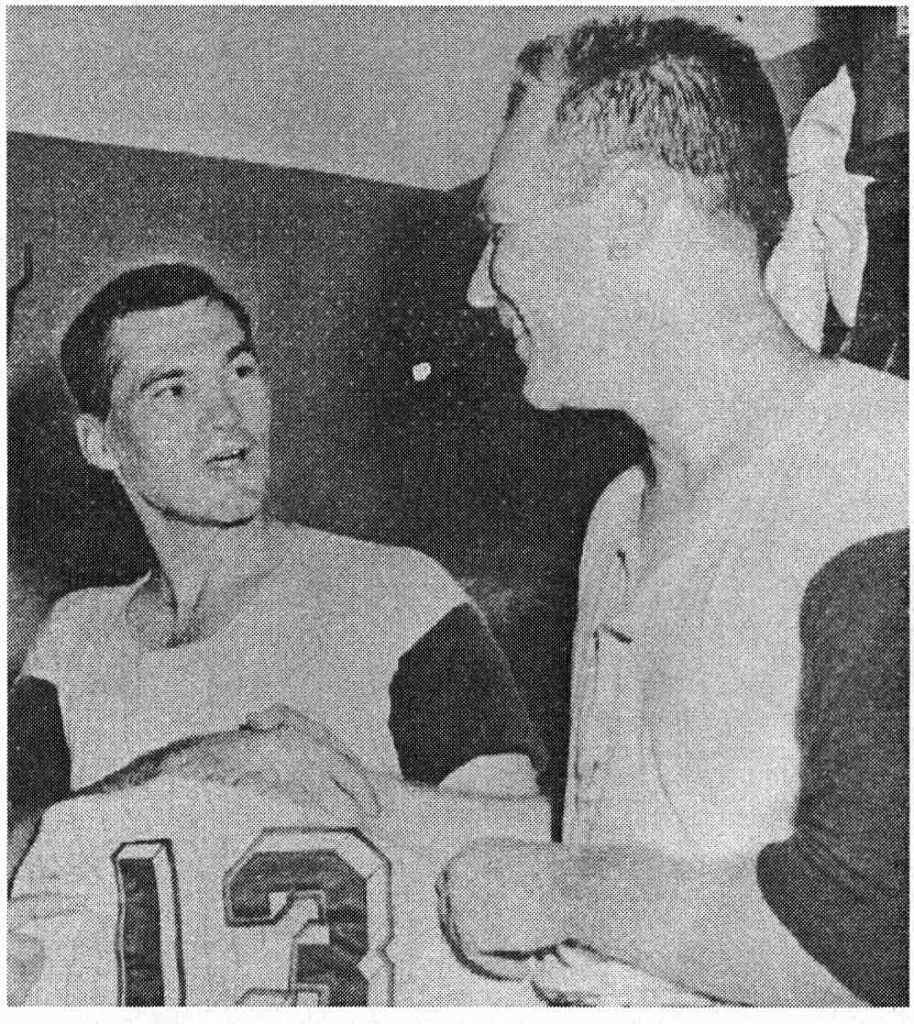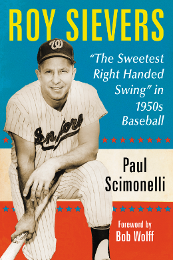By Jeff Stuart
On Dec 10, 1952, the Washington Senators traded Cuban Mike Fornieles to the Chicago White Sox for Chuck Stobbs, a 23 year old who broke in with the Red Sox at the age of 17 and already had 40 big league wins.”He doesn’t overpower anybody with his speed,” said manager Bucky Harris.”But he gets that good curve over the plate, and in the big Washington park, he ought to do even better. He looks ready to blossom into a winner.” In spite of being best known for giving up a famous 566 foot homer to Mickey Mantle that left Griffith Stadium on April 7, 1953, Stobbs was a pretty fair pitcher. A regular winner in 5 seasons with Boston, he won 7 and lost 11 for Chicago in 1952.
He registered a career-high 15 wins for the Senators in 1956. But 1957 was not a good year for the lefthander. He led the American League in Losses (20) and Earned Runs Allowed (126). Going into the June 21, 1957 game against the Cleveland Indians at Griffith Stadium, Chuck had lost 11 straight on the year and 16 straight including the later half of the 1956 season.
The Senator’s front office decided to intervene. The first 3200 fans arriving at the park received rabbit’s feet and coins imprinted with four leave clovers, courtesy of the National Brewing Company, a Nats sponsor. “None of this was my idea,” said Stobbs at the time. “It’s serious with me. But they certainly won’t do any harm.” He received many good luck phone calls and telegrams, letters, and cards throughout the day. Fans sent him voodoo dolls, horseshoes, a chip of the Blarney Stone, and other charms hopefully guaranteed to break a losing streak. It was also “Virginia Night” at the stadium. Both Stobbs and Jim Lemon, sons of the Old Dominion, were honored before the game. Stobbs was from Norfolk, VA. They presented Chuck with a live rabbit before the game. A teammate put ground up shamrock in his shoes. The U.S. Army sent Stobbs a miniature plastic model of its NIKE guided missle.
Stobbs could easily have won his first start of the year. Matched against the Yankees in New York on April 6 , opening day in NY, Stobbs doggedly dueled NY ace Whitey Ford. Roy Sievers put the Nats in front with a leadoff home in the 7th. But Yogi Berra tied it with a homer in the bottom half. Berra singled in the bottom of the ninth. After Gil McDougald doubled Berra to third, and Ellston Howard was intentionally walked, the Yanks third baseman Andy Carey fouled off six Stobbs pitches before singling to left on a 2-2 pitch to give NY the win and Chuck his first loss of the year. A week later Stobbs, in Washington, was not nearly as effective.losing again, 15-6. Mantle hit his first homer of the year.
On April 27 in Baltimore, Fornieles, the man the Nats traded to get Stobbs, gave up only 4 singles as the Orioles won, 4-1, dealing Chuck his third loss. Fornieles retired the first 13 men he faced. Stobbs gave up 8 hits, struck out 5 and walked only 1 in 7 innings. Washington had only 3 hits.
In Chicago on May 2, Walt Dropo’s pinch grand slam in the 6th doomed Stobbs, who again deserved a better fate. The Nats lost, 6-1. Dick Donovan gave up only 5 hits for the White Sox.
On May 6 in Kansas City, Stobbs gave up another grand slam, this one to Jim Pisoni of the A’s. KC scored 6 times in the first and never looked back, winning, 8-2. The lefthander was now, 0-5. And on May 12, in Boston, he lost again, 10-0. Tom Brewer of the Red Sox 2 hit the Nats in the first game of a doubleheader. Stobbs was shelled for 4 runs in the 3rd.On May 16 at Griffith Stadium against the White Sox, Dropo again homered off Chuck and the Nats offense against were shut out, this time by Jim Wilson. The Sox won, 5-0. Stobbs gave up only 7 hits but Wilson gave up just 4. On May 20, in Washington, Stobbs lasted just 2 innings as the Tigers won, 6-1 behand Duke Maas, who allowed only 5 Nats hits. Stobbs started off well retiring the first 2 baters but then Ray Boone singled and Charlie Maxwell homered.
There was another loss in New York, 8-1 on May 24. Stobbs, who had 3 complete game wins over the Bombers in 1956, lasted only 3 innings. Over a 2-year period the record for most losses was 23, by Clifton Curtis of the 1910-11 Boston Braves. For one season, it was 19, set by John Nabors of the 1916 Philadelphia A’s.
At 0-9 sportswriter Shirley Povich wrote,”A fan writes to suggest that Chuck Stobbs has lost confidence in himself; and it could be that he also has lost confidence in the Nats.” Now the headlines in the sports section of the Washington Post began to focus on Stobbs increasing frustration. “Bewildered Lefthander Beaten by Bosox, 11-1,” read the banner in the June 2 edition. “If C.K (Chuck) Stobbs thinks that someone has changed his two front initials to ,L.P.,’ no one will blame him,” wrote Bob Addie. ”’L.P.,’ of course is the prefix in baseball which means ‘losing pitcher” and Stobbs has had those letters in front of his name so often of late he must be bewildered.” The winning pitcher in that game was Willard Nixon of the Red Sox, who had not beaten Washinton since April, 20, 1955, losing 5 times and failing to survive seven starts against the Nats since then. His career record against Washington was only 4-11. He has a shutout until the 9th when the Nats got three singles and scored their lone run. In games in which Stobbs had appeared during the streak, the Nats had averaged only 2 runs per game. The crowd of some 9000 was the largest Saturday afternoon crowd in 2 years.
“Poor Stobbs Fails Again,” read the banner in the June 7 edition of the Post. On June 6 in Cleveland the Nats scored 5 runds in the 8th inning to win 11-7. But Stobbs was chased in the seventh with the Nats leading 7-5 and Vic Wertz on base when Tex Clevenger came on in relief. Rocky Colavito promptly homered to tie the game. “I made one mistake in giving Colavito a high fastball,” said Tex, who was the winner in relief. “If I had retired Colavito, Chuck would have had the win and he really could use it.”
On June 14, in Chicago, in his worst outing the streak, Chuck lost his 11th straight to the White Sox, 10-4, giving up all 10 runs in 5 innings. Dick Donovan had a shutout until the 9th.
That set the stage for the June 22 game at Griffith Stadium. With almost all the 9462 spectators carrying good luck charms, and Chuck himself donning a uniform with the number “13” on the back, instead of his usual number”18″, the Nats won, 6-3. Stobbs struck out 8, allowing 7 hits, and recording his first win since he blanked the Orioles, 2-0, on 4 hits on Sept 5, 1956. In addition to wearing the number “13,” Stobbs carried a silver dollar given to him by 80 year old coach Nick Altrock. Altrock had carried the silver dollar since 1906 when he was a star foe the Chicago White Sox, the fame “hitless wonders.” More important than the lucky Charms, Stobbs had the accumulated good will of the fans going for him. He struck out the second man to face him and the crowd roared. Chuck was cheered for every strike and each Cleveland out. The Senators got 10 hits overall. Sievers doubled twice knocking in 2 runs and Art Schult hit his first major league homer, a 2-run blast. When Al Smith grounded to Rocky Bridges in the bottom of the ninth, the drought was over. Stobbs became Washington’s first 20-game loser since 1916. Johnson won 25 that year. Still, it is pretty good company. And he did manage to win 8 games in just over a half a season, including complete game shutouts of the Red Sox on Aug 16 at home (5-0) and of at Baltimore (3-0) on Sept. 5. His 20th loss came on the final day of the season against Baltimore. And it came in a relief appearance. The Orioles won in 10 innings, 7-3. He held the Orioles scoreless in the 7th, 8th, and 9th. He pitched 211 innings in 1957, after pitching 240 in 1956. He was a dependable work horse, important to any staff.
Stobbs had a fine career in baseball, winning 107 games, with a 4.29 ERA. After being traded to the Cardinals in 1958, he returned to the Senators in 1959, began wearing glasses and became a standout relief pitcher, with a career-best ERA of 2.98. Often referred to as handsome by the local sportswriters of the day, Chuck was a fan favorite. I certainly was a fan.

Schult- (right> after breaking his 16-game losing
streak on June 21, 1957. Stobbs is holding
up his lucky 1/13″ uniform he had donned for
the occasion.






